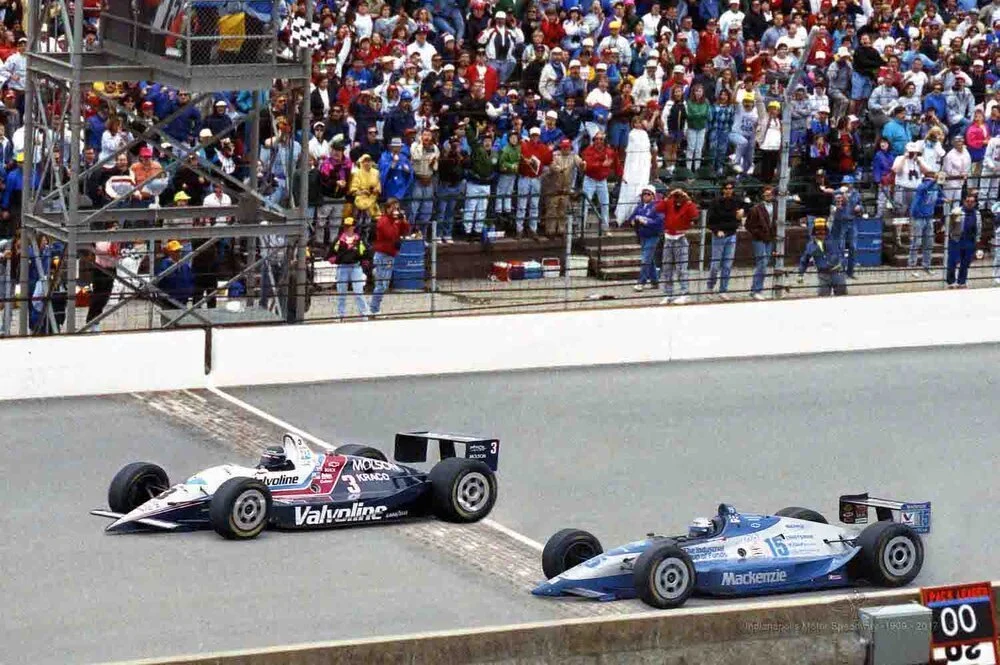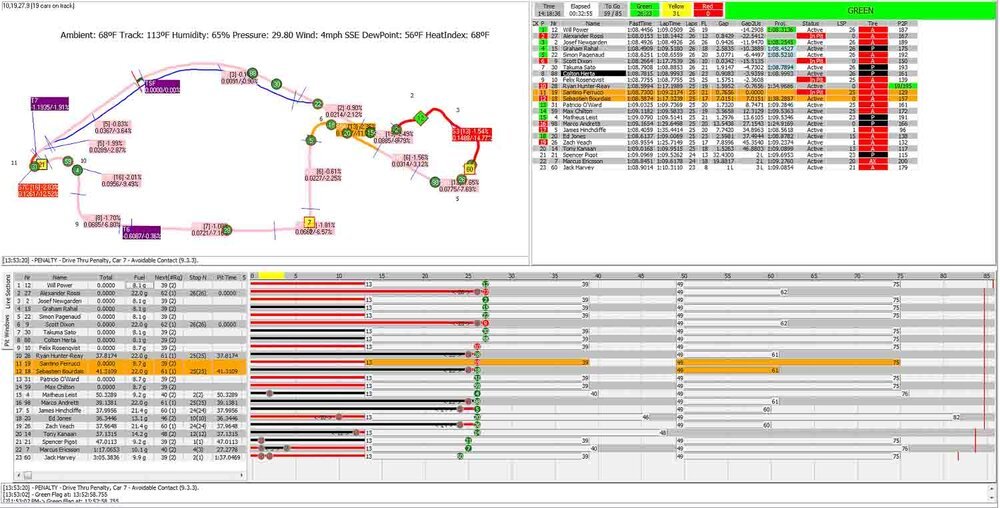From INDYCAR Racing to Business Success
Data creates advantages that wins sports championships and drives business success. That’s my key takeaway from having worked in INDYCAR racing and the tech industry.
After getting an MS in applied mathematics awarded with distinction, I worked as an INDYCAR engineer and race strategist. I helped my teams win many races and podium finishes by turning massive troves of data into millisecond advantages, and by gaining race positions through data-driven strategy executed at breakneck speed.
I competed in more than 100 races worldwide, including numerous Indianapolis 500s, and eventually became the head of data science at Andretti Autosport. I had the privilege of working with notable team drivers and owners such as Michael Andretti, Bobby Rahal, Jimmy Vasser, Will Power, Tony Kanaan, and Danica Patrick.
Then, after almost 10 years of racing, I transitioned to a career in tech.
Alex Castrounis (middle right) and Team Celebrating Winning the Historic Champ Car Finale | 2008 Grand Prix of Long Beach | Will Power - Team Driver and Race Winner - Interviewed by ESPN in Victory Circle
I’ve helped race teams and companies in many industries win by turning data into value, benefits, and results - ranging from INDYCAR teams, to early stage startups and Fortune 500 companies. Examples include leveraging artificial intelligence (AI), machine learning, and other advanced analytics techniques to win races, provide personalized products and offers, optimize supply chains, and accurately forecast demand - initiatives that have maximized profits and efficiency, increased revenues and customer retention, minimized costs, and maximized ROI.
Alex Castrounis (upper right) - Indy 500 Race Strategist and Engineer - Featured in Racer Magazine for Davey Hamilton’s famed comeback Indianapolis 500 race following 23 surgeries to reconstruct his legs and feet after a horrific crash at the Texas Motor Speedway in 2001 | Reprinted from RACER Magazine
Artificial Intelligence, Machine Learning, and IoT Before the Buzz
INDYCAR like the NFL, MLB, or NBA, is the top-tier professional racing league in the US, and consists of a multi-race season where teams accumulate points resulting in a championship winner. The Indy 500 is the marquee race of the season, and while debatable, some racers argue that winning the Indy 500 is more coveted than winning the championship.
Every INDYCAR has over 80 sensors that measure and record basically everything, and that data is transmitted over wireless telemetry to engineers and data scientists for real-time analysis. Over half of a trillion data samples are created by one car during the Indy 500 alone!
On-board INDYCAR Lap Data From the Grand Prix of Long Beach
Professional racing has been at the forefront of AI and IoT-driven innovation long before those became buzzwords. Winning race teams must be able to turn massive amounts of data into near real-time actionable insights. Businesses increasingly need to create value from massive amounts of data too, but most lag behind what race teams have been doing for a long time.
The Problem of Winning
Winning individual races, let alone winning consistently or a championship, is ridiculously difficult. It requires tens, if not hundreds of millions of dollars per year in the case of Formula One (F1). Competition is fierce: a tenth of a second may be the difference between starting 1st or 15th, and in many races the winner wins by a photo finish.
[VIDEO] Closest Indianapolis 500 Finish in History | Al Unser Jr. Beats Scott Goodyear by 0.043 Seconds at over 230 MPH | 1992 Indianapolis 500 | IMS Photo Archive | Video Footage Courtesy of IMS Productions
Drivers must be brave enough to drive a car 230+ MPH surrounded by concrete walls and unpredictable traffic. Also, the team and driver must have perfect pit stops, zero car and pit equipment failures, avoid dangerous racing traffic, and stay away from other cars’ crashes. Teams must do this all while working at an unrealistic pace, under intense pressure and accountability, and with a driver’s life on the line.
Alex Castrounis’ INDYCAR Team During a 2008 Indianapolis 500 Pitstop | Alex’s Role: Race Strategist and Engineer | IMS Photo Archive
Winning in business isn’t easy either, and just like in racing, winning consistently requires competitive advantage. That is, having a superior ability to assess, analyze, and act in order to accomplish goals and create value in ways that your competitors can’t.
Competitive advantage is an outcome that requires certain ingredients to create it. Data is the critical ingredient, along with the analytical skills to turn it into greater value than your competitors. Data enables you to win by continuously improving and optimizing over time.
A racing team’s ultimate ability to win for a given combination of track layouts 1 and conditions 2 is determined by a combination of a raw driver talent, the racecar setup 3 , and the race strategist’s ability to make critical, successful decisions in fractions of a second throughout a race.
Alex Castrounis - Race Strategist and Engineer - Preparing for the Start of the 2006 Indianapolis 500
A race car setup refers to a given combination of tunable car settings that are carefully chosen by highly specialized computer scientists, engineers, and data scientists to make the car go as fast as possible. The setup is critical, and the world's fastest race car driver can be slow and scared for their life when driving a car with a sub-optimal setup. The setup for a given combination of track and conditions is extremely hard to get right, and can have over a trillion possible combinations. It is often the difference between winning and losing.
Analogously, a company’s “setup” can be thought of as a combination of branding, talent, products, technology, and more - all geared to make the company as successful as possible in today’s high stakes, competitive business landscape. Companies have an almost infinite combination of choices and decisions to make, and must constantly adapt their setup to win. Slight company setup improvements can separate market winners from market losers.
In racing, a great race strategy can win a race even when the car isn’t fast enough to win from speed alone, and it helps teams to constantly adapt to changing race conditions. Similarly, companies must have winning strategies to succeed in changing conditions such as increased competition, new or changing regulations, and the ups and downs of the economy.
[VIDEO] INDYCAR Racers Trying to Win the 100th Running of the Indianapolis 500 | 2016 | IMS Photo Archive | Video Footage Courtesy of IMS Productions
The Champion’s Roadmap
Winning comes by leading, not following, an obvious and often under-appreciated fact. Winning generates revenue for businesses and sponsorship dollars for racing teams, which should be reinvested in growth and improvement. This creates more competitive advantage, more wins, and hopefully the cycle repeats.
Start of the 100th Running of the Indianapolis 500 | 2016 | IMS Photo Archive
Winning also creates the perception of having a winning brand, which results in greater credibility and more fans and customers. Winners look like heroes. Winners feel a sense of accomplishment and get validation that all the time, effort, and money was worth it.
Data is key to winning consistently. Data allows people to make objective decisions, take actions, and produce outcomes based on insights, patterns, and predictions as opposed to gut feel or simply doing whatever was done in the past. It allows us to quantify how good our underlying assumptions are, while knowing how much we can improve or optimize something. There really is no other way to get the same result.
Winning race car setups are chosen based on advanced analytics (AI and machine learning) and data science techniques using data from data acquisition systems, driver feedback, historic events, telemetry, testing (track, aerodynamic, suspension), computer simulation, and more. Likewise, winning race strategies are based on statistical analysis and advanced analytics (predictive and prescriptive) of data from historic races and weather, as well as computer simulations. These techniques make all the difference in finding the best performing car setup and race-winning strategy.
INDYCAR RaceTools Timing and Scoring Software
Professional motorsports provides a great model for business, but many companies struggle to become data-literate, data-informed, or data-driven. Decision-making based on historical precedent and gut feel can be habitual, comfortable, and the path of least resistance. This can be hard to overcome and will prevent your company from achieving or maintaining championship-winning results until things change.
For companies to succeed like championship-winning INDYCAR teams, they need to define a very small number of critical goals like INDYCAR teams do, e.g., winning the Indy 500, winning the championship, and securing millions of dollars in sponsorship. Every other goal, initiative or project should exist in support of those goals, and data is the fuel needed to achieve them.
Companies should adopt a culture of data-driven innovation. They should democratize data and make it responsibly accessible to anyone internally able to turn it into winning value.
Companies should have the right analytics leadership and talent in place, along with executive buy-in and sponsorship. They should have company-wide support, adoption, and alignment across business functions to help ensure focused, data-driven actionability and success.
Companies should responsibly use actionable insights to actually make decisions and take action. All the best insights in the world won’t matter for companies unwilling to act. Finally, companies should always know how to measure the performance and success of every decision made, action taken, or product feature built.
Conclusion
Luckily most businesses don’t deal with the extremes of INDYCAR racing, but they do have a lot in common. Companies that are able to think and operate like professional race teams will be more likely to win in their industry.
For companies that want to win, my advice is don’t succumb to analysis paralysis or not knowing where to start. Don’t wait. Do something instead of nothing. Don’t stick with the status quo.
The time is now and the race has started. The checkered flag is in front of you and you must get to it first. As they say in racing – green, green, green!!!
[VIDEO] Juan Montoya winning the Indianapolis 500 | Video Footage Courtesy of IMS Productions
FOOTNOTES
1 Super speedways, short ovals, road courses, and street courses.
2 Track conditions (e.g., wet, dry, abrasive, bumpy, or slick) and weather conditions (e.g., temperature, wind, barometric pressure, precipitation).
3 A combination of tunable car settings (e.g., aerodynamic, mechanical, suspension, drivetrain) that impacts the ultimate speed potential of the car, regardless of the driver.









